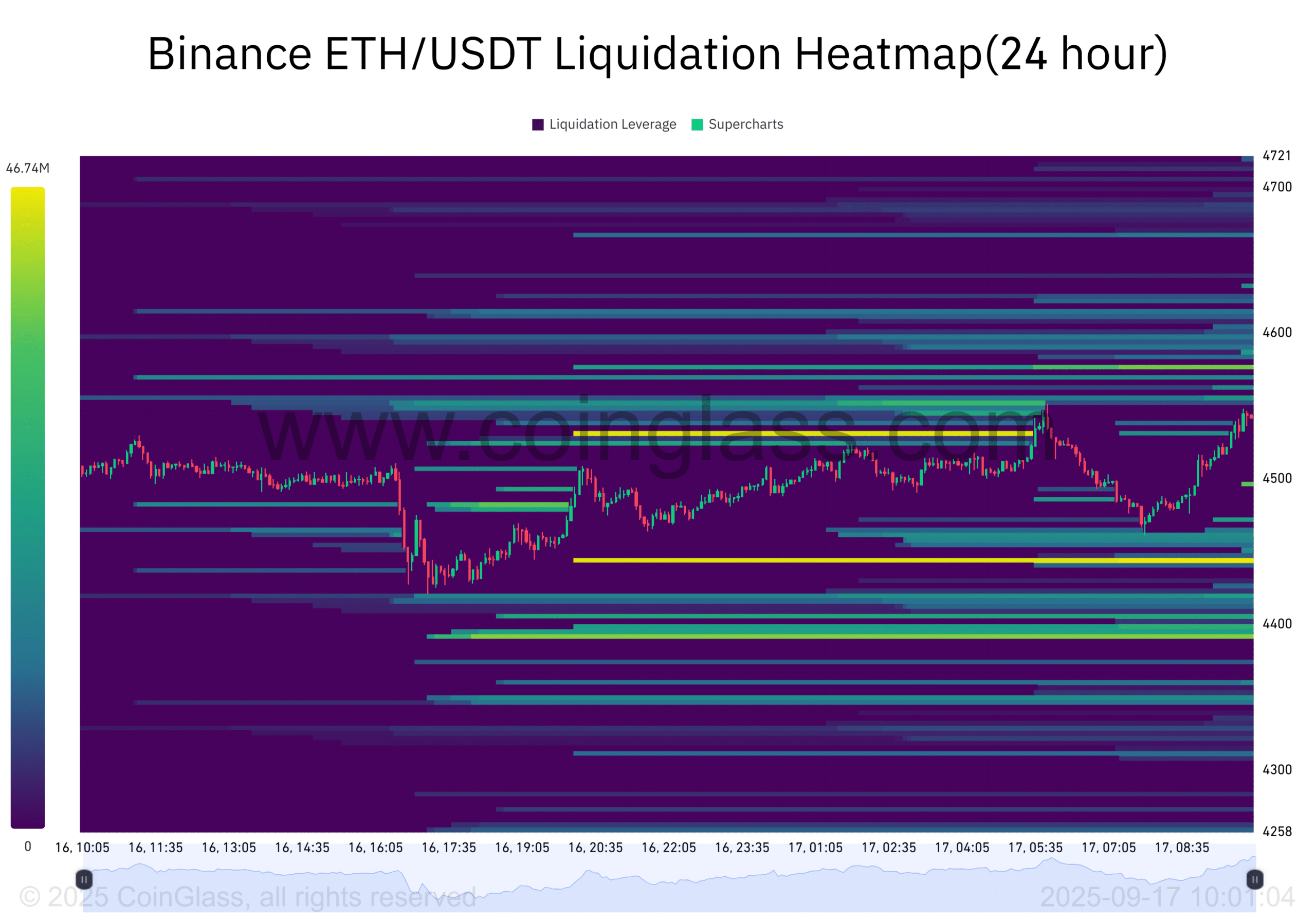Ethereum Could Extend Gains as Liquidation Spikes and Funding Rates Signal Bullish Momentum Versus Citi’s $4,300 Outlook
Contents
Ethereum price outlook: ETH liquidation spikes and a steady positive funding rate signal short-covering rallies that could push ETH above $4,700. On-chain metrics — rising staking inflows and falling exchange reserves — support a bullish bias versus conservative analyst targets.
-
Short liquidations near $4,500–$4,700 have driven sharper upside moves.
-
Funding rates near 0.005% indicate persistent long conviction among leveraged traders.
-
On-chain trends—rising staking inflows and declining exchange reserves—support demand, while macro risks keep volatility elevated.
Meta description: Ethereum price outlook: ETH liquidation spikes and steady funding rates support upside; monitor $4,500–$4,700 zones for breakout opportunities. Read the data-driven analysis.
What is the current Ethereum price outlook?
Ethereum price outlook shows bullish signs driven by concentrated short liquidations and steady positive funding rates. ETH’s on-chain data—rising staking inflows and lower exchange reserves—imply increasing supply tightness, which could help sustain a move above recent resistance levels in the near term.
How do liquidation spikes affect ETH price momentum?
Liquidation events force leveraged shorts and longs out of positions, often amplifying directional moves. Recent data showed heavy short liquidations outpacing longs, a dynamic that typically accelerates short-term rallies as shorts are squeezed and buyers absorb selling pressure.
At press time, ETH traded near $4,542 with reported short liquidations exceeding $9 million versus roughly $6 million in long liquidations, highlighting an imbalance that has tested resistance bands and fueled renewed buying strength.
Are liquidation spikes fueling bullish ETH momentum?
Yes. Concentrated short liquidations have been a clear driver of intraday and multi-day rallies. When shorts are forced out around critical bands, forced buying can lift prices quickly, testing higher resistance levels.
Data at press time recorded short liquidations above $9 million versus approximately $6 million in long liquidations, while ETH traded near $4,542. Such imbalances tend to increase volatility, creating rapid breakouts or sharp reversals depending on follow-through liquidity.
Traders should watch liquidation volumes and the pace of re-entry by new long positions, since repeated cycles of liquidation and re-leverage can create a feedback loop that escalates moves.

Source: CoinGlass (data reported as an on-chain and derivatives analytics provider; referenced here as plain text)
How do Funding Rates reflect trader sentiment?
Funding Rates act as a real-time indicator of leverage bias: positive funding means longs pay shorts, indicating bullish positioning. ETH’s OI-weighted funding has hovered around 0.005% at press time, signaling steady demand for long exposure among leveraged traders.
While not extreme, a consistent positive premium suggests conviction. However, elevated funding over extended periods can increase the risk of sharp corrections if sentiment suddenly flips.
Key liquidation zones that could define Ethereum’s next breakout
Heatmaps highlight concentrated liquidation clusters between $4,500 and $4,700. These bands are where leveraged positions cluster and where cascading liquidations can occur if ETH breaches or is rejected at those levels.
If ETH clears this band convincingly, cascading short liquidations could amplify an upward move. Conversely, repeated rejection in the same zone may attract fresh short interest and increase downside risk.

Source: CoinGlass (funding and open interest analytics cited as plain text)
What are the scenarios for ETH: follow Citi’s caution or break higher?
Market signals currently favor a break higher rather than strictly honoring Citigroup’s conservative $4,300 year-end target. Liquidation imbalances, persistent positive funding, and clustered heatmap pressure all point to bullish conviction in the short term.
That said, macroeconomic uncertainty and episodic liquidity shocks can still produce sharp corrections. A sustained break above $4,700 would materially improve the odds of a run toward higher targets, while repeated rejections would keep downside scenarios viable.

Source: CoinGlass (liquidation heatmap displayed as a plain-text source)
Frequently Asked Questions
How can traders use liquidation data to time entries?
Traders can watch for concentrated short liquidation clusters and a decline in liquidation pressure after a breakout. Entering on confirmed break and reduced liquidation intensity can lower the risk of immediate squeeze-driven reversals.
What does a persistent positive funding rate mean for ETH holders?
A persistent positive funding rate means leveraged traders are paying to hold longs, indicating bullish bias. Long-term holders should remain aware that prolonged positive funding can precede sharp corrections if sentiment shifts.
Key Takeaways
- Liquidation imbalances matter: Short liquidations have driven recent upside and can trigger rapid moves.
- Funding rates show conviction: A consistent 0.005% funding premium suggests sustained long interest.
- Watch $4,500–$4,700: This band is a decisive zone—clearance could validate bullish scenarios; rejection may invite fresh shorts.
Conclusion
Ethereum price outlook currently favors upward momentum driven by concentrated liquidation events, steady positive funding, and supportive on-chain flows. While macro uncertainty and occasional re-leveraging can create volatility, the consolidated data suggests ETH is positioned to test and potentially clear resistance near $4,700 if current trends persist. Monitor liquidations, funding, and exchange reserves closely for confirmation.
Comments
Yorumlar
Other Articles
Bitwise Files for 11 Altcoin ETFs Including AAVE, UNI Amid SOL, XRP Muted Gains
December 31, 2025 at 08:47 PM UTC
Ethereum Stablecoins Reach 2025 Peaks Led by USDT, Amid Sustained Activity
December 31, 2025 at 07:01 PM UTC
Bitwise Seeks SEC Approval for 11 Crypto ETFs Targeting AAVE, UNI, TAO
December 31, 2025 at 01:17 PM UTC

